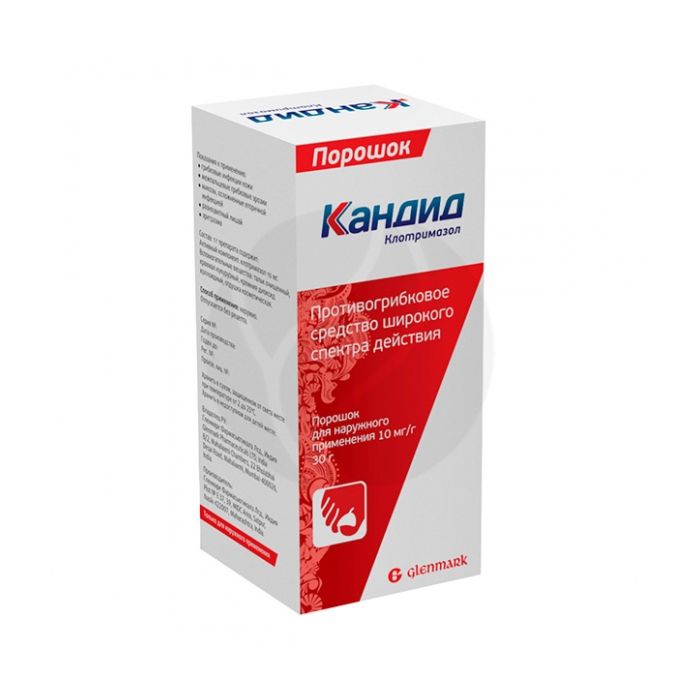Candide powder for external use 1%, 30g
Expiration Date: 05/2027
Russian Pharmacy name:
Кандид порошок для наружного применения 1%, 30г
Fungal infections of the skin;
interdigital fungal erosion;
mycoses complicated by secondary infection;
versicolor versicolor;
erythrasma.
Outwardly. The powder is applied to the affected area of ??the skin 3-4 times / day. Improvement occurs within 3-5 days. Regular use of the drug is important for successful treatment. The duration of therapy is individual and depends on the severity and localization of the disease. To achieve complete recovery, you should not stop treatment with the drug immediately after the disappearance of acute symptoms of inflammation or subjective complaints.
The duration of therapy should be, on average, about 4 weeks; with pityriasis versicolor - 1-3 weeks, with erythrasma - 2-4 weeks. With interdigital fungal erosions of the legs, it is recommended to continue therapy for about 2 weeks after the relief of symptoms of the disease.
Powder for external use from white to light yellow, with a characteristic odor.
1 g
clotrimazole 10 mg
Excipients: purified talc - 925 mg, corn starch - 50 mg, colloidal silicon dioxide - 10 mg, cosmetic perfume - 5 mg.
I trimester of pregnancy;
hypersensitivity to clotrimazole or excipients.
The drug should be prescribed with caution during lactation.
pharmachologic effect
Broad-spectrum antifungal agent for external use. The action of clotrimazole is associated with a violation of the synthesis of ergosterol, which is part of the cell membrane of fungi, which changes the permeability of the cytoplasmic membrane and causes subsequent cell lysis. In small concentrations, it acts fungistatically, in large concentrations it is fungicidal, and not only on proliferating cells. In fungicidal concentrations, it interacts with mitochondrial and peroxidase enzymes, resulting in an increase in the concentration of hydrogen peroxide to a toxic level, which also contributes to the destruction of fungal cells.
Clotrimazole exhibits fungicidal and fungistatic activity against dermatomycetes (Trichophyton rubrum, Trichophyton mentagrophytes, Epidermophyton floccosum, Microsporum canis), yeast-like and mold fungi (Candida spp., Including Candida spp., Including Candida Rusta albicans; Torulopsis albicans; Torulopsis genus, Torulopsis albicans; Active against the causative agent of varicoloured lichen - Pityrosporum orbiculare (Malasseziafurfur). Effective against gram-positive bacteria - the causative agent of erythrasma Corynebacterium minutissimum, as well as Staphylococcus spp., Streptococcus spp., Gram-negative bacteria - Bacteroides, Gardnerella vaginalis. In high concentrations, it is active against Trichomonas vaginalis.
Does not affect lactobacilli. Primarily resistant variants of sensitive fungi are very rare; the development of secondary resistance in sensitive fungi is also observed in exceptional cases under therapeutic conditions.
Pharmacokinetics
When applied externally, after applying clotrimazole to intact or inflamed skin, it is poorly absorbed through the skin and practically does not have a systemic effect. Cmax of clotrimazole in blood serum was below the detection limit of 0.001 ?g / ml.
Side effect
From the immune system: allergic reactions, incl. urticaria, shortness of breath, arterial hypotension, fainting.
Skin and subcutaneous tissue disorders: rash, itching, blisters, peeling, pain / discomfort, swelling, burning, irritation, erythema, tingling.
Application during pregnancy and lactation
Use is contraindicated in the first trimester of pregnancy. Application in the II-III trimesters of pregnancy is possible only in cases where the intended benefit to the mother outweighs the potential risk to the fetus.
If necessary, use during lactation should decide on the termination of breastfeeding.
Application for violations of liver function
In patients with hepatic impairment, the functional state of the liver should be monitored periodically.
Application in children
It is possible to use in children according to indications, in doses and dosage forms recommended according to age. It is necessary to strictly follow the instructions in the instructions for clotrimazole preparations for the use in children of different ages of specific dosage forms of clotrimazole and for contraindications for specific age groups in this category of patients.
special instructions
If allergic reactions or irritation occurs at the site of application of the product, treatment is stopped.
Hygiene rules should be followed to prevent reinfection.
Application of clotrimazole to the skin around the eyes is not recommended.
If clinical signs of infection persist after completion of treatment, a second microbiological study should be performed to confirm the diagnosis.
Drug interactions
With simultaneous use with amphotericin B, nystatin, the activity of clotrimazole decreases.
The simultaneous use of intravaginal clotrimazole and oral tacrolimus, sirolimus can lead to an increase in the concentration of the latter in the blood plasma, therefore, patients should be monitored for the development of symptoms of their overdose, if necessary, with the measurement of plasma concentrations.

